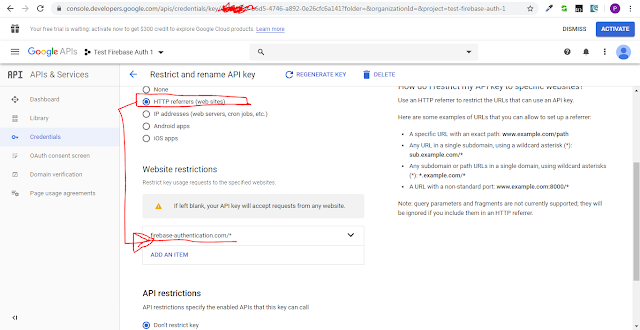|
First go to https://firebase.google.com/docs/web/setup and create a project step by step by following https://console.firebase.google.com/.
|
|
Step 2: Register your app with Firebase Go to https://console.firebase.google.com/u/0/project/test-firebase-auth-1/authentication/providers for enable signin method. I enabled Email/Password authentication type for this example. |
|
To initialize Firebase in your app, you need to provide your app's Firebase project configuration. Go to Project Settings page for configure app and get API Key. |
Step 3: Add Firebase SDKs and initialize Firebase, we will use CDN to load all necessary resources <script src="//www.gstatic.com/firebasejs/7.14.0/firebase-app.js"></script> <script src="//www.gstatic.com/firebasejs/7.8.1/firebase-auth.js"></script> <script type="text/javascript"> $(document).ready(function () { // Your web app's Firebase configuration var firebaseConfig = { apiKey: "AIzaSyA9XqTsdfsdfsdf0w9TSlYSlUlpCLcNjeM", authDomain: "test-firebase-auth-1.firebaseapp.com", databaseURL: "https://test-firebase-auth-1.firebaseio.com", projectId: "test-firebase-auth-1", storageBucket: "test-firebase-auth-1.appspot.com", messagingSenderId: "514502059460", appId: "1:51450324232059460:web:70b12cd2342345ee4287f932f091" }; // Initialize Firebase var defaultProject = firebase.initializeApp(firebaseConfig); console.log(defaultProject.auth()); }); </script> |
|
You can restrict your API Key to specific domain using below steps: 1. Visit https://console.developers.google.com/apis 2. Go to your firebase project 3. Go to Credentials 4. Under API keys, select the Browser key associated with your firebase project (should have the same key as the API key you use to initialize your firebase app.) 5. Under "Accept requests from these HTTP referrers (web sites), simply add the URL of your app. |
|
We are done from configure Firebase. Now we will build our registration/login page. |
Request Sample When User State Changed (Login,Logout,Registration)defaultProject.auth().onAuthStateChanged(function(user) { if (user) { console.log("Logged in user details"); console.log(user); console.log(user.displayName); console.log(user.email); } else { window.location.href = "/"; } }); |
Request Sample to Register User With Email/PassworddefaultProject.auth().createUserWithEmailAndPassword(email, password).catch(function(error) { console.log(error); if (error.message) { alert(error.message); } }); |
Request Sample to Login ActiondefaultProject.auth().signInWithEmailAndPassword(email, password).catch(function(error) { console.log(error); if (error.message) { alert(error.message); } }); |
Password Reset Email Send RequestdefaultProject.auth().sendPasswordResetEmail(email).then(function() { alert('Password Reset Email Sent!'); }).catch(function(error) { console.log(error); if (error.message) { alert(error.message); } }); You can configure password reset URL |
You can reset your password using below code snippetconst queryString = window.location.search; const urlParams = new URLSearchParams(queryString); const code = urlParams.get('oobCode'); defaultProject.auth().confirmPasswordReset(code, "Password-123456").then(function() { alert('Password Reset Completed'); }).catch(function(error) { console.log(error); if (error.message) { alert(error.message); } }); |
|
Finally GibHUB link to the sample project
|
Showing posts with label firebase-authentication. Show all posts
Showing posts with label firebase-authentication. Show all posts
Friday, April 17, 2020
Firebase Authentication for Web - Sign-in Method Email/Password Implementation
Subscribe to:
Comments (Atom)












